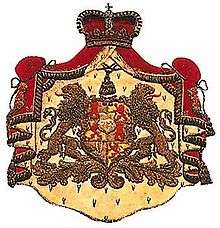Prince Gustav of Thurn and Taxis
| Prince Gustav | |||||
|---|---|---|---|---|---|
| Prince Gustav of Thurn and Taxis | |||||
| Born |
22 August 1888 Dresden, Kingdom of Saxony | ||||
| Died |
30 April 1919 (aged 30) Munich, Bavarian Soviet Republic | ||||
| |||||
| House | House of Thurn and Taxis | ||||
| Father | Prince Franz of Thurn and Taxis | ||||
| Mother | Countess Theresia Grimaud of Orsay | ||||
| Religion | Roman Catholic | ||||
Prince Gustav Franz Maria of Thurn and Taxis,[1][2] full German name: Gustav Franz Maria, Prinz von Thurn und Taxis[1][2][3] (22 August 1888, Dresden, Kingdom of Saxony[1][2] – 30 April 1919, Munich, Bavarian Soviet Republic[1][2]), was a member of the House of Thurn and Taxis and a Prince of Thurn and Taxis by birth. As a member of the Thule Society, Gustav was killed by the Bavarian Soviet Republic (German: Bayerische Räterepublik) government during the German Revolution of 1918–19.
Family
Gustav was the fourth child and second son of Prince Franz of Thurn and Taxis and his wife Countess Theresia Grimaud of Orsay.[1][2] Through his father, Gustav was a grandson of Maximilian Karl, 6th Prince of Thurn and Taxis and his wife Princess Mathilde Sophie of Oettingen-Oettingen and Oettingen-Spielberg.
Life
Gustav studied philosophy at the University of Tübingen. After fighting in World War I, he became a member of the Thule Society (German: Thule-Gesellschaft), a German occultist and völkisch group in Munich, named after a mythical northern country from Greek legend.[3][4]
German Revolution
As White Guard (German: Weisse Garde) forces (a coalition of Prussian and Bavarian troops combined with Freikorps) surrounded Munich, the Communists began to raid nationalist strong points throughout the city.[4][5] On 26 April 1919, the Red Army (German: Rote Armee) broke into the Thule Society premises and arrested secretary Countess Heila von Westarp, Gustav, and five other members, labelling them as "right-wing spies."[3][4][5] Gustav and the other hostages were taken to the cellar of the Luitpold Gymnasium, which had served as a Red Army post since mid-April.[4] The seven Thule Society members, including Gustav, and three Freikorps soldiers were killed on 30 April as a reprisal for reports of the killing of Red soldiers by Whites at Starnberg.[4][6] Gustav and his fellow hostages were lined up against a wall and executed by a firing squad.[3][7] Their deaths may have also been a reprisal for an attempt by Thule Society members to infiltrate the Bavarian Soviet Republic's government and stage a coup d'état on 30 April. Gustav was the most notable of the four titled members killed in the incident, due to his family's extensive ties with several of Europe's royal houses.[3][4]
Bavarian nuncio Eugenio Pacelli (the later Pope Pius XII) referred to the fights and the murder of the hostages in an article in the newspaper "Bayerischer Kurier" (founded in 1856) on October 1, 1919: "The Nunciature itself was riddled with bullets during the fights between communists and republican government troops. Armed spartacists entered here with force, and when I protested against the violation of international law I was threatened with a gun. I know in what gruesome manner the hostages were murdered."[8]
Titles, styles, honours and arms
| Styles of Prince Gustav of Thurn and Taxis | |
|---|---|
 | |
| Reference style | His Serene Highness |
| Spoken style | Your Serene Highness |
| Alternative style | Sir |
Titles and styles
- 22 August 1888 – 30 April 1919: His Serene Highness Prince Gustav of Thurn and Taxis
Honours
Ancestry
| Ancestors of Prince Gustav of Thurn and Taxis | ||||||||||||||||||||||||||||||||||||||||||||||||||||||||||||||||||||||||||||||||||||||||||||||||||||||||||||||||||||||||||||||||||||||||||||||||||||||||||||||||||||||||||||||||||||||||||||||||||||||||||||||||||||||||||||||||||||||||||||||||||||||||||||||||||||||||||||||||||||||||||||||||||||||||||||||||||||||||||||||||||||||||||||||||||||||||||||||||||||||||||||||||||||||||||||||||||||||||||||||||||||||||||||||||||||||||||||||||||||||||||||||||||||||||||||||||||||||||||||||||||||||||||||||||||||||||||||||||||
|---|---|---|---|---|---|---|---|---|---|---|---|---|---|---|---|---|---|---|---|---|---|---|---|---|---|---|---|---|---|---|---|---|---|---|---|---|---|---|---|---|---|---|---|---|---|---|---|---|---|---|---|---|---|---|---|---|---|---|---|---|---|---|---|---|---|---|---|---|---|---|---|---|---|---|---|---|---|---|---|---|---|---|---|---|---|---|---|---|---|---|---|---|---|---|---|---|---|---|---|---|---|---|---|---|---|---|---|---|---|---|---|---|---|---|---|---|---|---|---|---|---|---|---|---|---|---|---|---|---|---|---|---|---|---|---|---|---|---|---|---|---|---|---|---|---|---|---|---|---|---|---|---|---|---|---|---|---|---|---|---|---|---|---|---|---|---|---|---|---|---|---|---|---|---|---|---|---|---|---|---|---|---|---|---|---|---|---|---|---|---|---|---|---|---|---|---|---|---|---|---|---|---|---|---|---|---|---|---|---|---|---|---|---|---|---|---|---|---|---|---|---|---|---|---|---|---|---|---|---|---|---|---|---|---|---|---|---|---|---|---|---|---|---|---|---|---|---|---|---|---|---|---|---|---|---|---|---|---|---|---|---|---|---|---|---|---|---|---|---|---|---|---|---|---|---|---|---|---|---|---|---|---|---|---|---|---|---|---|---|---|---|---|---|---|---|---|---|---|---|---|---|---|---|---|---|---|---|---|---|---|---|---|---|---|---|---|---|---|---|---|---|---|---|---|---|---|---|---|---|---|---|---|---|---|---|---|---|---|---|---|---|---|---|---|---|---|---|---|---|---|---|---|---|---|---|---|---|---|---|---|---|---|---|---|---|---|---|---|---|---|---|---|---|---|---|---|---|---|---|---|---|---|---|---|---|---|---|---|---|---|---|---|---|---|---|---|---|---|---|---|---|---|---|---|---|---|---|---|---|---|---|---|---|---|---|---|---|---|---|---|---|---|---|---|---|---|---|---|---|---|---|---|---|---|---|---|---|---|---|---|---|---|---|---|---|---|---|---|---|---|---|---|---|---|---|---|---|---|---|---|---|---|---|---|---|---|---|---|---|---|---|---|---|---|---|---|---|---|---|---|---|---|---|---|---|---|---|---|---|---|---|---|---|---|---|---|---|---|---|---|---|---|---|---|---|---|---|---|---|---|---|---|---|---|
| ||||||||||||||||||||||||||||||||||||||||||||||||||||||||||||||||||||||||||||||||||||||||||||||||||||||||||||||||||||||||||||||||||||||||||||||||||||||||||||||||||||||||||||||||||||||||||||||||||||||||||||||||||||||||||||||||||||||||||||||||||||||||||||||||||||||||||||||||||||||||||||||||||||||||||||||||||||||||||||||||||||||||||||||||||||||||||||||||||||||||||||||||||||||||||||||||||||||||||||||||||||||||||||||||||||||||||||||||||||||||||||||||||||||||||||||||||||||||||||||||||||||||||||||||||||||||||||||||||
References
- 1 2 3 4 5 Darryl Lundy (13 Dec 2008). "Gustav von Thurn und Taxis". thePeerage.com. Retrieved 2010-01-01. External link in
|publisher=(help) - 1 2 3 4 5 Paul Theroff. "THURN und TAXIS". Paul Theroff's Royal Genealogy Site. Retrieved 2010-01-01.
- 1 2 3 4 5 Malinowski, Stephan (2003). Vom König zum Führer: sozialer Niedergang und politische Radikalisierung im deutschen Adel zwischen Kaiserreich und NS-Staat. Akademie Verlag. ISBN 3-05-004070-X.
- 1 2 3 4 5 6 Goodrick-Clarke, Nicholas (1993). The Occult Roots of Nazism: Secret Aryan Cults and Their Influence on Nazi Ideology. New York City, New York: New York University Press. ISBN 0-8147-3060-4.
- 1 2 Destination Munich (2009). "Communist Munich: Before the fascists came the reds - Behind Communist Munich". Destination Munich. Retrieved 2010-01-01. External link in
|publisher=(help) - ↑ Flood, Charles Bracelen (1989). Hitler, the path to power. Houghton Mifflin. ISBN 0-395-35312-2.
- ↑ Evans, Richard J. (2004). The coming of the Third Reich. Penguin Books. ISBN 1-59420-004-1.
- ↑ Bayerischer Kurier No. 417, 10/01/1919; cf. also Morgenblatt 10/01/1919 (original German text: "Die Nuntiatur selbst wurde während des Kampfes zwischen den Kommunisten und republikanischen Regierungstruppen mit Kugeln gespickt. Bewaffnete Spartakisten drangen mit Gewalt hier ein, und als ich energisch protestierte gegen diese Verletzung des internationalen Rechts, hat mich einer von ihnen mit seinem Revolver bedroht. Ich weiß, auf welche verabscheuungswürdige Weise die Geiseln ermordet wurden.")